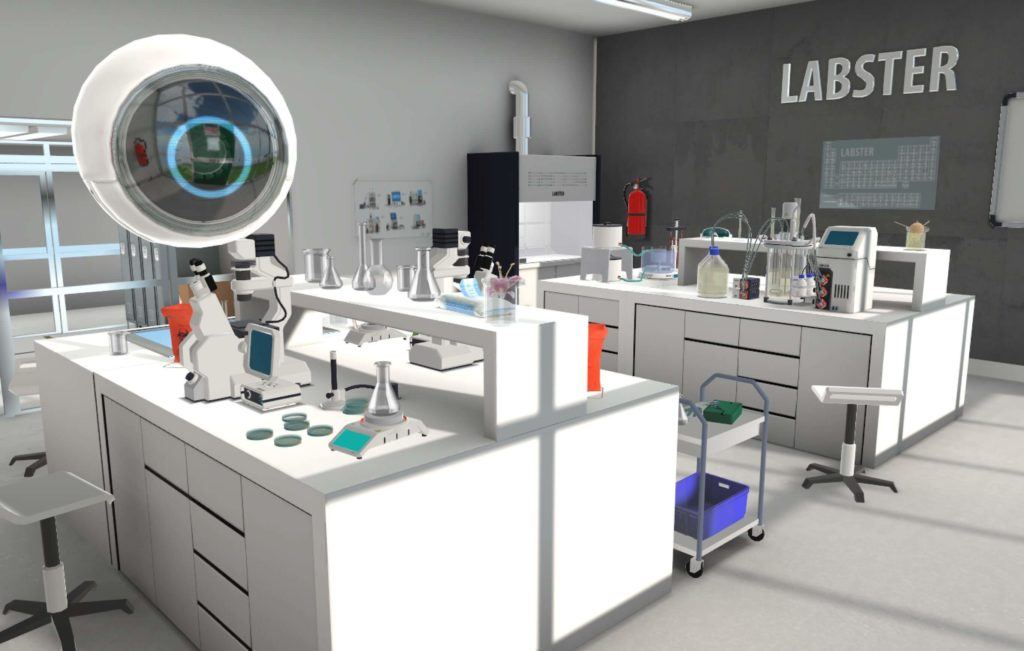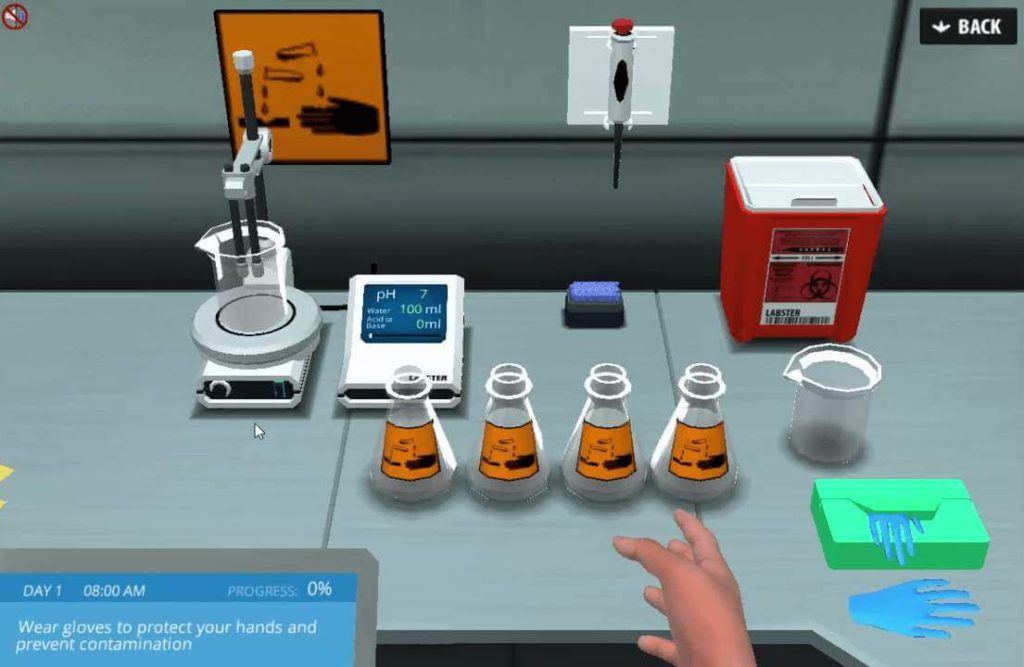Labster – teaching lab experiments in VR

Labster is redefining how students learn and experience science. Through immersive VR and gamification, Labster recreates a virtual lab, saving millions of dollars for schools and universities worldwide.
With the emergence of virtual reality, teaching science will never be the same.
Denmark and Indonesia-based Labster develops interactive advanced lab simulations using the methods of gamification. Its content is delivered in either VR or through a digital interface.
Labster has already developed more than 50 simulations across different scientific disciplines, including topics such as protein synthesis, medical genetics, or embryology. It has partnered with prominent global universities such as Harvard Medical School, MIT, Stanford, Berkeley, or ETH Zurich. It has received more than $10M from scientific institutions to aid with R&D.
As hardware is improving rapidly, VR headsets and simulators such as sensor gloves are becoming more versatile and expanding their capabilities. While flight simulators have long been the industry norm, gamified VR lab experiments have yet to enter mainstream education.

Value Creation
Immersive teaching through experiments in the lab is probably some of the most effective modes of education. Students are able to engage fully and understand complex phenomena from the natural world by observing how they happen. Laboratory facilities require space and cost hundreds of thousands of dollars to outfit with complex equipment. Moreover, some experiments require rare chemicals, which sometimes can create dangerous or explosive reactions. Not only are the lab sessions gamified, but the software product also presents the story through an engaging plot and measures students’ content understanding via integrated quizzes.

Labster creates value by redefining the lab. This asset-light software model eliminates the need for expensive equipment, makes the content accessible from your pocket, and democratizes a hands-on learning experience. Hence, the key value of Labster is the affordable and easily distributable content with a strong educational purpose. Its functionalities are virtually unlimited, allowing the students to learn from a wide array of subjects, spanning from chemistry, physics, biology, or even forensics.
Moreover, Labster’s platform is not limited to VR headsets. The content has been optimized for laptops and iPads, allowing students to also simulate the experience in a similar fashion to video games. This cross-platform content leads to even stronger reach.
Value Capture
So far, Labster’s business model has focused on partnership efforts with key educational institutions in Europe and beyond. Interestingly, Labster is working on both developing the software with these institutions while also selling the product to them directly. The firm is using a clear B2B model, in which the institution is able to sign up for an array of simulations and pay per student or through an annual subscription fee similar to the SaaS model. Since each simulation requires a thorough understanding of the underlying science and possible outcomes from each step along each experiment, Labster will have the difficult job to discover and provide this information to its users.
What should Labster do?
Keep Engaging key stakeholders: Since teachers are the direct point of contact to the students, it is in their hands to engage them with Labster’s digital content. They are the motivators and the messengers who will create the industry pull for this innovation. While students are using similar technologies such as game consoles on a regular basis, educational change will have to engage multiple stakeholders. The decision-maker in such institutions is still the board of directors or the principal of the school or university. Hence, Labster needs to actively engage with all stakeholders who will create both a strong push as well as a natural pull for this digital educational tool. To strengthen the pull strategy, Labster can leverage its brand and produce inbound marketing materials such as blog posts or white papers. It has already done a successful study to compare its effectiveness of teaching the content digitally vs conventionally and has discovered that combining Labster with conventional classroom methods improves content assimilation by over 100%.
Distance Learning: One potential path for the future development of the platform is to move into the field of remote education. Labster is perfectly positioned to enter the world of online education and break into educational platforms such as CourseEra or EdX . Teachers and students can be represented on the platform through their digital avatars, allowing for an even more immersive experience. Eventually, the platform can simulate a full classroom of students from around the world who have logged in to learn from their remotely based teacher.

Multi-homing opportunities: Multi-homing here is a broader way to describe the case in which an experiment is done both in real life as well as in VR. A possible avenue that Labster could explore is to work together with suppliers of both raw materials and equipment for the experiments. Featuring the equipment brand on a specific machine in the digital simulation will create awareness amongst the users of the platform. Labster could potentially provide a ready-to-order set of raw materials and supplies for each simulation in the case that the teacher decides to also perform the experiment in real life. This will aid in additional revenues from suppliers for these extra sales. Labster, however, would not benefit from holding this inventory but could rather work on a commission basis.
Labster is a platform that is poised for growth. It has already reached impressive milestones and keeps improving and expanding. VR learning is a tremendous opportunity, on which early movers such as Labster are already capitalizing on. Connecting and engaging students to science is creating value well beyond the traditional scope of a business.
Labster is giving us a look into that bold future of immersive digital education.
Sources:
https://uploadvr.com/vr-will-revolutionize-education/
https://www.labster.com/about/
http://www.educationdive.com/news/3-ways-vr-is-poised-to-reshape-learning-iste-2016/422233/



Loved your post Lidiya. You have not seized to amaze me with all the things you know about technology–it is truly inspiring. Aside from educational institutions, who do you think are the best target consumers for this product? Big pharma or chemical businesses come to mind?
Hi Lidiya! Thanks for the great post! I think Labster would be very valuable to scientific organizations to teach students. However, one objective of science experiments is to discover new scientific mechanisms (like chemical reactions etc.). I believe Labster is able to run lab simulations because the data about how chemicals react with each other would have been inputted into it. However, this data would not exist for reactions that have not been tried, right? Do you think this would reduce Labster’s utility for laboratories?
Hi Bipul – that is a great point. I agree with you that Labster is not the best at the discovery stage. The reason is that Labster comes in much earlier as a teaching tool to get students excited about science who would otherwise never have had the opportunity to set food in a lab. So many students already drop off from STEM education because it has historically been not only very challenging, but has had very limited resources and has not managed to make the educational process a bit simpler, a bit more engaging, and a bit more fun. So this is where Labster adds the most value. I would argue that for the next step – the research and discovery of new scientific knowledge will probably continue to happen within a real lab. Just see how this simulation is 100x cooler than reading boring descriptions about cells and molecules: https://www.youtube.com/watch?v=oairUMkieak .